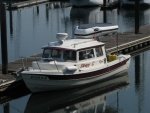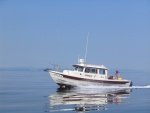Just in to my dealer was my deposit for a C-Dory 26 Standard Venture with split bunk aluminum trailer. Anticipated delivery to MI is next spring for dealer rigging. Lots to consider since last cruising boat, brand new technology with electronics (I used Loran C then GPS), new bottom paints, changed cruising laws (?) and a human torso that can't quite do what it used to, although there are minimal complaints. Really like the Garmin electronics.
Anticipated cruising areas are Great Lakes including bordering Canada, coastal US, inland lakes and rivers, ICW, PNW maybe more. Some of these: deja vu. Looking for a fresh and salt water bottom paint (VC Offshore?).
Outta the blocks, we omitted the marine toilet and went with the Air Head composting upgrade still begging the question about grey water from galley and shower in Canada.
Engines are not decided. I initially like the twin 90 Evinrude ETecs due to performance and less weight but now am turned off by oil consumption/storage for longer cruises. Honda/Yamaha 90's will most likely get the vote.
Not liking stowing a dinghy on the pilothouse with 2 old rotator cuff injuries so this is still undecided.
Later, we may add cockpit canvas and stern solar panel(s).
I am ready to entertain your 'Top Ten' suggestions for accepting delivery and rigging a new C-Dory. Yes, we'll get insurance and, no, I don't need your favorite onboard recipes.
Aye.
Anticipated cruising areas are Great Lakes including bordering Canada, coastal US, inland lakes and rivers, ICW, PNW maybe more. Some of these: deja vu. Looking for a fresh and salt water bottom paint (VC Offshore?).
Outta the blocks, we omitted the marine toilet and went with the Air Head composting upgrade still begging the question about grey water from galley and shower in Canada.
Engines are not decided. I initially like the twin 90 Evinrude ETecs due to performance and less weight but now am turned off by oil consumption/storage for longer cruises. Honda/Yamaha 90's will most likely get the vote.
Not liking stowing a dinghy on the pilothouse with 2 old rotator cuff injuries so this is still undecided.
Later, we may add cockpit canvas and stern solar panel(s).
I am ready to entertain your 'Top Ten' suggestions for accepting delivery and rigging a new C-Dory. Yes, we'll get insurance and, no, I don't need your favorite onboard recipes.
Aye.


